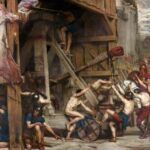You have certainly come across many interesting visualizations on the Internet showing what Rome might have looked like in the times of the Empire. Impressive, right? However, it is always worth considering how much truth there is in these beautiful graphics. And I don’t mean only whether the structure of individual buildings was correctly drawn by a graphic artist, because the question of the architecture of the buildings in ancient Rome will always be a matter of interpretation of archaeological data, hypotheses, etc. I rather mean whether the appearance the city as a whole is realistic.
And here comes the weakness of almost all reconstructions available on the Internet: they are perfect. They show the city in a state as if – to use a modern comparison – the developer had just left the construction site and handed over the “keys to the city” to the investor. They ignore the fact that even at its peak in the 2nd century CE. Rome was an ancient city, with roots dating back almost a thousand years. It was built with both new monumental imperial buildings, but also countless old buildings with varying degrees of “wear and tear”. Even then it was a city of contrasts, where next to marble public buildings there were old, crumbling insula, and next to new forums and old temples worn down by the teeth of time.
The source texts are full of mentions that this or that emperor renovated some building. This means that before renovation it had to be in a condition where renovation work was already necessary. For example, Vitruvius writes in his work “On the Architecture of Books This shows that the Romans themselves, in a sense, assumed that buildings had a “lifespan”, required regular maintenance, and that after eighty years without significant repair work, they were worthless. By the way, the Vitruvian example is proof that the concept of depreciation of fixed assets known to our accountants existed already two thousand years ago.
But let’s get back to Rome: graphic designers who treat us to wonderful visualizations of the ancient capital completely forget that this city, at every moment of its rich history, has always consisted of buildings in various states of repair. Some were new, others deteriorated due to age, still others were destroyed by fires and were waiting for reconstruction. It is worth recalling that fires were a common problem plaguing the Romans. And more importantly, the great buildings destroyed by fire were often not rebuilt immediately. Sometimes it took many years to rebuild them. For example, the so-called the first Pantheon built by Marcus Agrippa on the Campus Martius was destroyed by fire in 80 AD, and in its place Hadrian built the temple that stands in Rome to this day only over 40 years later. This means that for several decades there were ruins in this place, or at best an empty square… The Temple of Jupiter on the Capitoline Hill also burned several times and sometimes it was necessary to wait a long time for its reconstruction. The unfinished and partially devastated large buildings in Nero’s Domus Aurea were developed for the following decades, until then they had to be a makeshift structure. Another example is the Theater of Marcellus, which was renovated in the 1st century AD. (under the Flavians), and later it was neglected so much that in the times of the Severans (early 3rd century) it required another urgent renovation.
Let’s look at our modern cities, which are a mixture of completely new buildings, those worn away by time, those whose plaster is falling off in whole patches, ruins threatening to collapse, buildings undergoing renovation and those where demolition has just started. The walls of our cities are covered with scribbles, and the walls of Rome looked no different (here, additional archaeological arguments are provided by the excavations in Pompeii, where, freshly unearthed, the walls of houses were dotted with various inscriptions – from official election announcements to simple graphomaniac pseudo-erotic works of “male folk poetry”).
Unfortunately, there is no trace in the computer visualizations that even at the peak of its glory, Rome was a city with many faces – just like our modern metropolises. There are no traces of ruts on the pavement, no walls cracked here and there, no plaster falling off, no frescoes worn out here and there, no traces of erosion on the stone facings of the oldest buildings or uneven steps worn out by hundreds of thousands of feet treading on them over the centuries. There are no walls blackened by sacrificial smoke or altars drenched in animal blood. There is no animal excrement or mountains of garbage on the streets. In the visualizations, everything is new and sterile.
Therefore, when you watch beautiful visualizations of ancient Rome, remember that they relate to reality in the same way as the folder of a developer selling apartments in a new housing estate relates to the images of this housing estate after several dozen years ;-)







